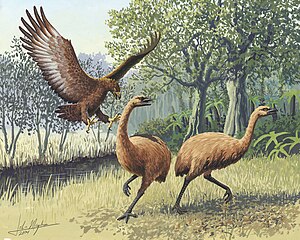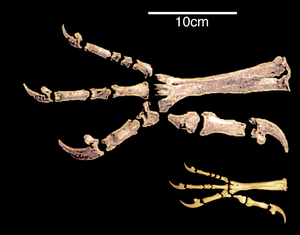Haast's Eagle
Haast's eagle (Hieraaetus moorei) is an extinct species of eagle that lived in the South Island of New Zealand, commonly accepted to be the pouākai of Māori mythology. It is the largest eagle known to have existed, with an estimated weight of 15 kilograms (33 pounds), compared to the next-largest and extant harpy eagle (Harpia harpyja), at up to 9 kg (20 lb). Its massive size is explained as an evolutionary response to the size of its prey—the flightless moa—the largest of which could weigh 230 kg (510 lb). Haast's eagle became extinct around 1445, following the arrival of the Māori, who hunted moa to extinction, introduced the Polynesian rat (Rattus exulans), and destroyed large tracts of forest by fire.
| Haast's eagle Temporal range: Pleistocene to Late Holocene | |
|---|---|
 | |
| Skull at the Canterbury Museum, Christchurch | |
| Scientific classification | |
| Domain: | Eukaryota |
| Kingdom: | Animalia |
| Phylum: | Chordata |
| Class: | Aves |
| Order: | Accipitriformes |
| Family: | Accipitridae |
| Genus: | Hieraaetus |
| Species: | †H. moorei |
| Binomial name | |
| †Hieraaetus moorei (Haast, 1872) | |
| Synonyms | |
| |
Taxonomy
Haast's eagle was first scientifically described by Julius von Haast in 1871 from remains discovered by the Canterbury Museum taxidermist, Frederick Richardson Fuller, in a former marsh. Haast named the eagle Harpagornis moorei after George Henry Moore, the owner of the Glenmark Estate, where the bones of the bird were found. The genus name was from the Greek harpax, meaning "grappling hook", and ornis, meaning "bird".
DNA analysis later showed that this bird is related most closely to the much smaller little eagle (Hieraaetus morphnoides) as well as the booted eagle (Hieraaetus pennatus) and not, as previously thought, to the large wedge-tailed eagle (Aquila audax). Harpagornis moorei was therefore reclassified as Hieraaetus moorei.
H. moorei is estimated to have diverged from these smaller eagles as recently as 1.8 million to 700,000 years ago. If this estimate is correct, its increase in weight by ten to fifteen times is an exceptionally rapid weight increase. The suggested increase in the average weight of Haast's eagle over that period would therefore represent the largest, fastest evolutionary increase in average weight of any known vertebrate species. This was made possible in part by the presence of large prey and the absence of competition from other large predators, an example of ecological release and island gigantism. A recent mitochondrial DNA study found it to be more closely related to the little eagle than the booted eagle, with an estimated divergence from the little eagle around 2.2 million years ago. It was placed in the genus Aquila by recent taxonomists.
Description

Haast's eagle was one of the largest known true raptors. In length and weight, it was even larger than the largest living vultures. Another giant eagle more recently and scantily described from the fossil record, the Woodward's eagle, which resided in North America, rivaled the Haast's in at least the aspect of total length. Female eagles were larger than males. Most estimates place the female Haast's eagles in the range of 10–15 kg (22–33 lb) and males around 9–12 kg (20–26 lb).
A comparison with living eagles of the Australasian region resulted in estimated masses in Haast's eagles of 11.5 kg (25 lb) for males and 14 kg (31 lb) for females. One source estimates that the largest females could have weighed more than 16.5 kg (36 lb). The largest extant eagles, none of which are verified to exceed 9 kg (20 lb) in a wild state, are about forty percent smaller in body size than Haast's eagles.

It had a relatively short wingspan for its size. It is estimated that the grown female typically spanned up to 2.6 m (8 ft 6 in), possibly up to 3 m (10 ft) in a few cases. This wingspan is broadly similar to the larger range of female size in some extant eagles: the wedge-tailed eagle, golden eagle (A. chrysaetos), martial eagle (Polemaetus bellicosus), white-tailed eagle (Haliaeetus albicilla) and Steller's sea eagle (Haliaeetus pelagicus) are all known to exceed 2.5 m (8 ft 2 in) in wingspan. Several of the largest extant Old World vultures, if not in mean mass or other linear measurements, probably exceed Haast's eagle in average wingspan as well.
Haast's eagle's relatively short wingspan has sometimes led it to being incorrectly portrayed as having evolved toward flightlessness, even though evidence strongly suggests that it flew. Instead, its short and broad wings represents an evolutionary departure from the mode of its ancestors' soaring flight in favour of navigating through a crowded woodland environment. Haast's eagles are likely to have hunted within the dense scrubland and forests of New Zealand.
Some wing and leg remains of Haast's eagles permit direct comparison with living eagles. The harpy eagle, the Philippine eagle (Pithecophaga jefferyi), and the Steller's sea eagle are the largest and most powerful living eagles, and the first two also have a similarly reduced relative wing-length as an adaptation to forest-dwelling. A lower mandible from the Haast's eagle measured 11.4 cm (4+1⁄2 in) and the tarsus in several Haast's eagle fossils has been measured from 22.7 to 24.9 cm (8+15⁄16 to 9+13⁄16 in). In comparison, the largest beaks of eagles today (from the Philippine and the Steller's sea eagle) reach a little more than 7 cm (3 in); and the longest tarsal measurements (from the Philippine and the Papuan eagle, Harpyopsis novaeguineae) top out around 14 cm (5+1⁄2 in).
The talons of the Haast's eagle were similar in length to those of the harpy eagle, with a front-left talon length of 4.9 to 6.15 cm (1+15⁄16 to 2+7⁄16 in) and a hallux-claw of possibly up to 11 cm (4+1⁄2 in). The Philippine eagle might be a particularly appropriate living species to compare with the Haast's eagle, because it too evolved in an insular environment from smaller ancestors (apparently basal snake eagles) to island gigantism in the absence of large carnivorous mammals and other competing predators. The eagle's talons are similar to modern eagles, suggesting that it used its talons for hunting and not scavenging.
The strong legs and massive flight muscles of these eagles would have enabled the birds to take off with a jumping start from the ground, despite their great weight. The tail was almost certainly long, in excess of 50 cm (20 in) in female specimens, and very broad. This characteristic would compensate for the reduction in wing area by providing additional lift. Total length is estimated to have been up to 1.4 m (4 ft 7 in) in females, with a standing height of approximately 90 cm (2 ft 11 in) tall or perhaps slightly greater.
Māori cave art depicts the Haast's eagle with a pale head. These Māori rock art drawings can still be found in modern-day South Canterbury near Timaru.
Combined with its vulture-like feeding behaviour, this might suggest it had a bald head, or had shorter feathers on its head than elsewhere on its body.
Behaviour

The Haast's eagle predominantly preyed on large, flightless bird species, including the moa, which ultimately lead to the species extinction. Moa would be up to fifteen times the weight of the eagle. Its large beak also could be used to rip into the internal organs of its prey and death then would have been caused by blood loss. Due to the absence of other large predators or kleptoparasites, a Haast's eagle could easily have monopolised a single large kill over a number of days.
A 2021 analysis showed that, while predatory, the bill of the Haast's eagle was functionally closer to that of the Andean condor (Vultur gryphus) than to that of other eagles. This is also supported by historic Māori Cave art which depicts the Haast's eagle being pale-headed. It also suggests that it deployed feeding tactics more similar to those of vultures after making a kill, plunging its head into the body cavity to devour the vital organs of its prey. This may have been an adaptation as a result of the bird hunting animals much larger than itself.
Extinction
Until recent human colonisation that introduced rodents and cats, the only placental land mammals found on the islands of New Zealand were three species of bat. Birds occupied or dominated all major niches in the New Zealand animal ecology. Moa were grazers, functionally similar to deer or cattle in other habitats, and Haast's eagles were the hunters who filled the same niche as top-niche mammalian predators, such as bears, big cats, or wolves.
One study estimated the total population of Haast's eagle at 3,000 to 4,500 breeding pairs. Early Māori settlers arrived in New Zealand some time between AD 1250 and AD 1275, Māori preyed heavily on large flightless birds, including all moa species, eventually hunting them to extinction by around 1445. Both eagles and Māori probably competed for the same foods. Unlike humans, eagles were dependent on medium and large-sized flightless birds. The loss of its primary prey caused the Haast's eagle to become extinct at about the same time.
Relationship with humans
Some believe that these birds are described in many legends of the Māori mythology, under the names pouākai, Hakawai, or Hōkioi in the North Island. According to an account given to Sir George Grey—an early governor of New Zealand—Hōkioi were huge black-and-white birds with yellow-green tinged wings and a red crest. In Māori mythology, Pouākai would prey and kill humans along with moa, which scientists believe could have been possible if the name relates to the eagle, given the massive size and strength of the bird. However, it has also been argued that the "hakawai" and "hōkioi" legends refer to the Austral snipe—in particular the extinct South Island species.
In popular culture

Artwork depicting Haast's eagle now may be viewed at OceanaGold's Heritage and Art Park at Macraes, Otago, New Zealand. The sculpture, weighing approximately 750 kg (1,650 lb), standing 7.5 metres (25 ft) tall, and depicted with a wingspan of 11.5 metres (38 ft) is constructed from stainless steel tube and sheet and was designed and constructed by Mark Hill, a sculptor from Arrowtown, New Zealand.
There is also a statue depicting the Haast's eagle in Karamea, West Coast. This statue was unveiled by the local community and the Ngāti Waewae iwi.
See also
References
External links

- Martinson, Paul (2006). "Haast's Eagle. Harpagornis moorei". Wellington: Te Papa Press. Archived from the original on 17 October 2012. Retrieved 6 May 2022.
Artwork produced for the book Extinct Birds of New Zealand by Alan Tennyson
- Wingspan Birds of Prey Trust
- "Haast Eagle". New Zealand Birds Limited.
- "New Zealand Eagle". NZ Conservation Trust. Archived from the original on 27 September 2007.
Charles Douglas' reputed sighting
- "Harpagornis Moorei". Te Papa Tongarewa: Museum of New Zealand.
- Haast's Eagle on BBC
This article uses material from the Wikipedia English article Haast's eagle, which is released under the Creative Commons Attribution-ShareAlike 3.0 license ("CC BY-SA 3.0"); additional terms may apply (view authors). Content is available under CC BY-SA 4.0 unless otherwise noted. Images, videos and audio are available under their respective licenses.
®Wikipedia is a registered trademark of the Wiki Foundation, Inc. Wiki English (DUHOCTRUNGQUOC.VN) is an independent company and has no affiliation with Wiki Foundation.



